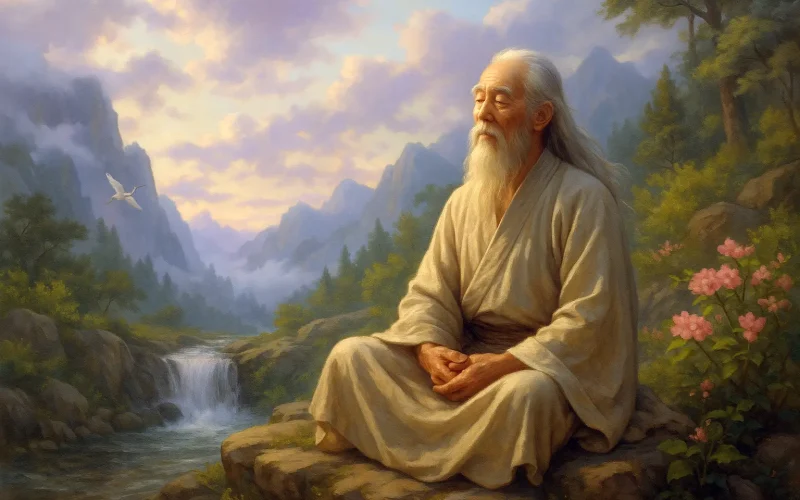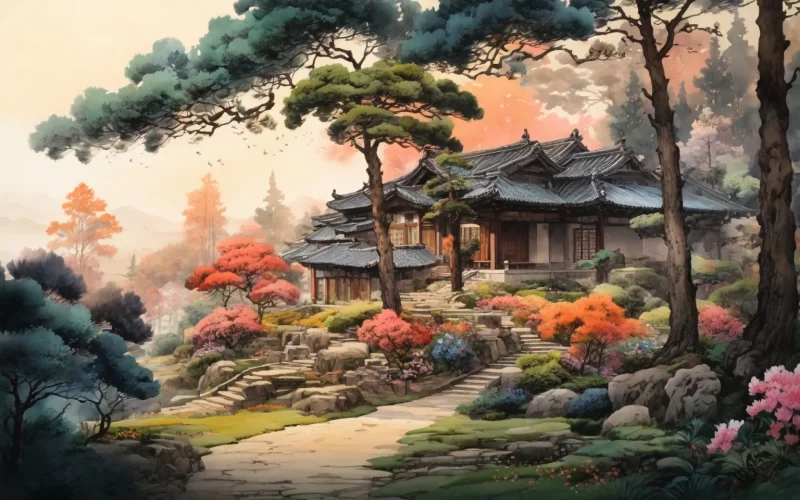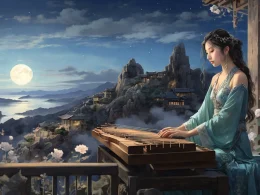The cliffs pierce the blue sky, green and steep;
Carefree, you don’t remember the years deep.
Parting the clouds, I search the pathway old;
Leaning on rock, I hear the stream water cold.
The flowers are warm where blue oxen lie;
The pines are high where white cranes sleep.
Our talk over, we find the river’s dyed by twilight;
Alone, I come down through the cold mist in sight.
Original Poem
「寻雍尊师隐居」
李白
群峭碧摩天,逍遥不记年。
拨云寻古道,倚石听流泉。
花暖青牛卧,松高白鹤眠。
语来江色暮,独自下寒烟。
Interpretation
Composed during Li Bai's later travels in Xuancheng, this work stands as a representative piece among his Taoist-inspired poems. Having experienced career setbacks and life fluctuations, the poet developed deeper identification with Taoist reclusive philosophy. Although the historical details of "Master Yong" remain unclear, his image embodies Li Bai's complete imagination of an ideal personality—a realized Taoist who transcends time and space, communing with the spirit of heaven and earth.
First Couplet: "群峭碧摩天,逍遥不记年。"
Qún qiào bì mó tiān, xiāoyáo bù jì nián.
Jade cliffs pierce the sky's domain; Carefree, he marks no year's reign.
The opening sketches the recluse's macro-environment through an upward gaze. "Jade cliffs pierce the sky" depicts both the mountains' emerald hue and, through the verb "pierce," grants the peaks dynamic force actively approaching the firmament. Against this backdrop, "carefree, marks no year" reveals the protagonist's existential state—juxtaposing spatial infinity with temporal stagnation, instantly creating an immortal realm beyond the mundane.
Second Couplet: "拨云寻古道,倚石听流泉。"
Bō yún xún gǔ dào, yǐ shí tīng liú quán.
Parting clouds, I seek the ancient way; Leaning on stone, I hear streams play.
This couplet portrays the visitation process with delicate brushwork. "Parting clouds" literally describes mist-shrouded mountains while metaphorically suggesting truth-seeking requires clearing worldly obscurities. "Seeking the ancient way" refers to both physical paths and symbolic pursuit of ancient Taoist wisdom. "Leaning on stone, hearing streams" shifts from visual to auditory; "hear" conveys the poet's inner stillness and沉醉 in nature's rhythm, transforming the journey into spiritual purification.
Third Couplet: "花暖青牛卧,松高白鹤眠。"
Huā nuǎn qīng niú wò, sōng gāo bái hè mián.
Warm flowers host the blue ox's rest; Tall pines cradle the white crane's nest.
This couplet presents the poem's most immortal scene. The blue ox (Laozi's mount) and white crane (immortals' companion) are classic Taoist symbols. By depicting animals' serenity rather than the master directly, the poet highlights the environment's perfect harmony. "Warm flowers" and "tall pines" not only outline the dwelling's layered beauty but also hint at the recluse's warm character and lofty virtue through antithesis.
Fourth Couplet: "语来江色暮,独自下寒烟。"
Yǔ lái jiāng sè mù, dú zì xià hán yān.
Our talk ends as river gleams dusk's hue; Alone I descend through cold mist's view.
The conclusion achieves emotional升华 through temporal flow. "Our talk ends" is highly inclusive—omitting specific dialogue yet implying spiritual resonance and self-forgetting conversation. "River's dusk hue" marks a complete time-space unit's end. The closing "alone descend through cold mist" contrasts with the majestic opening, transitioning from warm communion to cool solitude, leaving lingering resonance with both wistfulness and enlightened clarity.
Holistic Appreciation
The poem's artistic structure resembles a complete pilgrimage. It follows an internal logic of "observing the realm from afar → seeking its path → contemplating its manifestations → comprehending its spirit," progressing layer by layer. Li Bai skillfully interweaves his personal search (dynamic, process-oriented) with the recluse's transcendent image (static, perfected), jointly forming a complete philosophical diagram of "seeking Dao" and "attaining Dao." The color palette is particularly exquisite: from "jade cliffs" emerald to "warm flowers" brightness, then to "river's dusk" gold and "cold mist" gray, creating a rich yet harmonious visual rhythm that perfectly externalizes the poet's complex emotions from yearning and seeking to understanding and returning.
Artistic Merits
- Deliberate Spatiotemporal Design: The poem completes a spatial cycle (outside → inside → return) and temporal transition (day → dusk), achieving rigorous structure with symbolic meaning.
- Organic Integration of Taoist Imagery: Symbols like blue ox and white crane blend seamlessly with the environment, constructing a Taoist-charged symbolic system rather than appearing as stiff decorations.
- Layered Sensory Description: Integrating vision (jade cliffs, dusk hue), touch (warm flowers, cold mist), and hearing (streams) creates an immersive poetic space through multisensory experience.
- Masterful Use of Negative Space: Without direct description of the recluse, his image emerges entirely through environmental ambiance and the poet's indirect perception, reaching the artistic pinnacle of "expression through non-expression."
Insights
This poem reveals life wisdom particularly precious in modern society: true "seclusion" isn't physical escape but spiritual construction and guardianship. What Li Bai sought was not merely a recluse but an internal order and tranquility. In our information-overloaded, accelerated era, while we may not dwell in emerald mountains, we can carve out an inner sanctuary of "carefree timelessness," "leaning on stone to hear streams" during busy intervals to reclaim life's rhythm. The concluding "alone descend through cold mist" serves as profound metaphor: all deep spiritual exchanges ultimately return to solitary journeys, and genuine growth completes itself through this lonely sedimentation. This ability to maintain stillness amid noise and preserve independence within crowds constitutes Li Bai's spiritual legacy for every modern individual.
About the poet

Li Bai (李白), 701 - 762 A.D., whose ancestral home was in Gansu, was preceded by Li Guang, a general of the Han Dynasty. Tang poetry is one of the brightest constellations in the history of Chinese literature, and one of the brightest stars is Li Bai.












